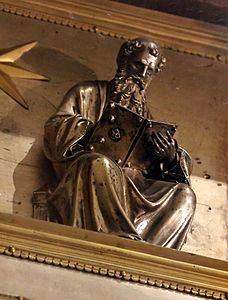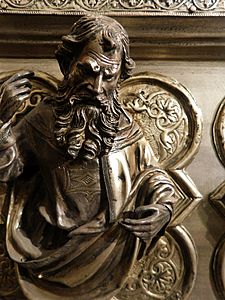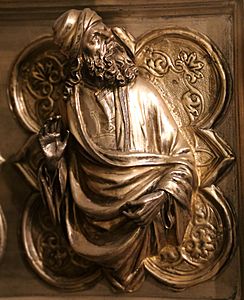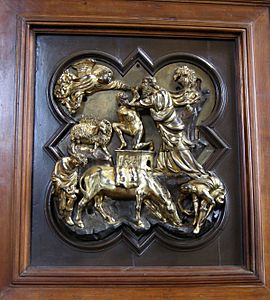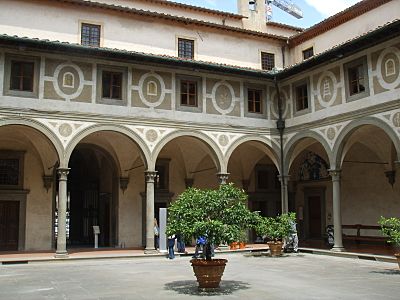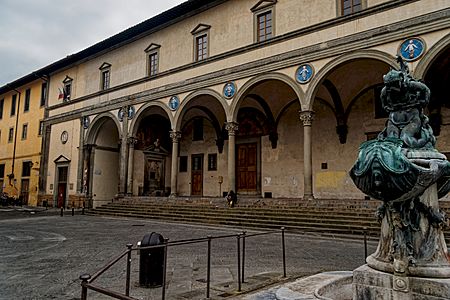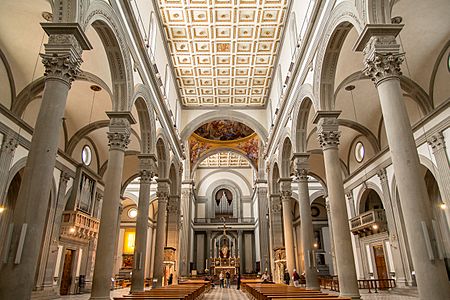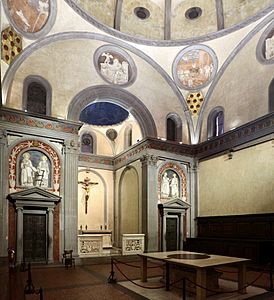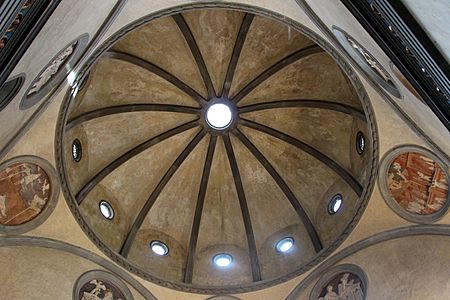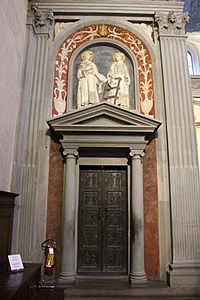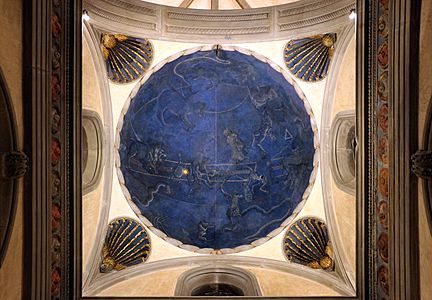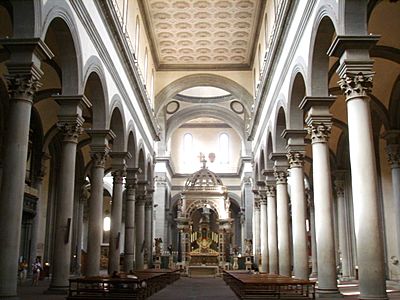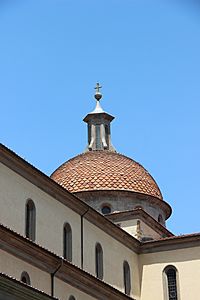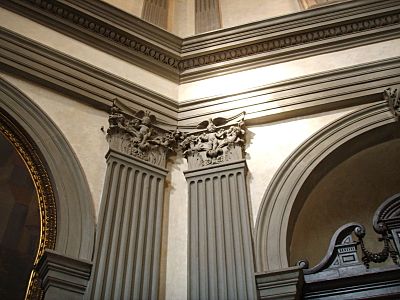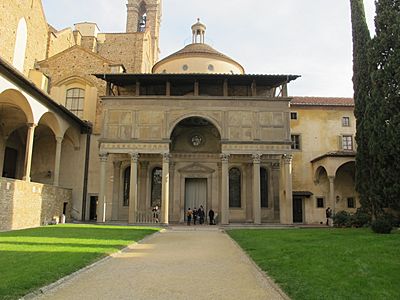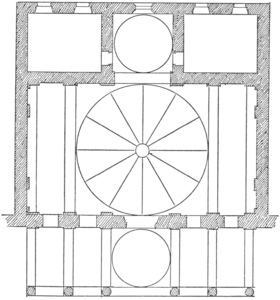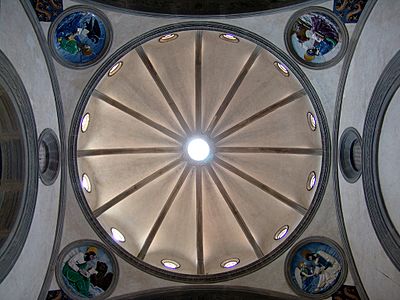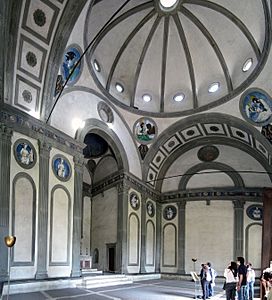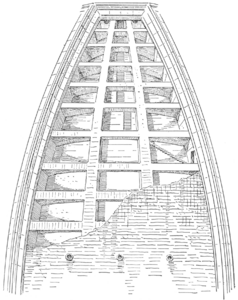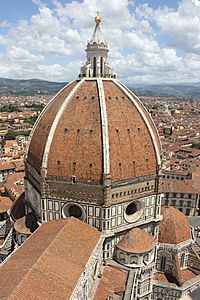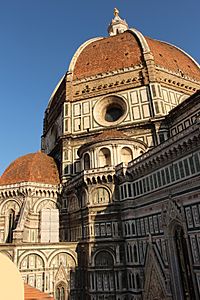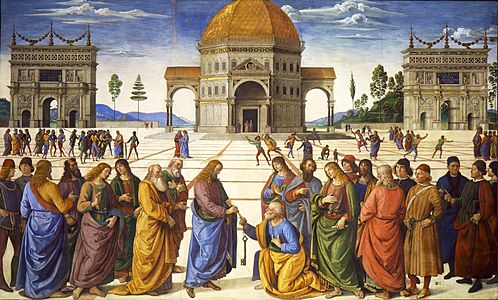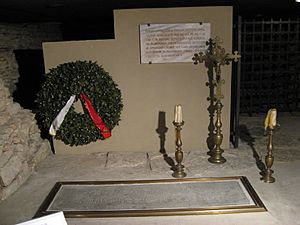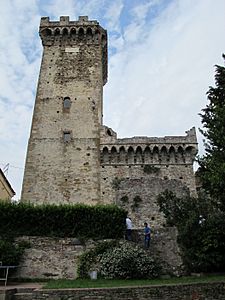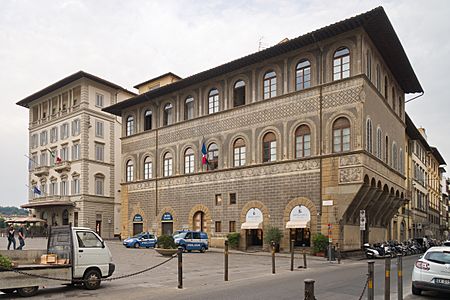Filippo Brunelleschi facts for kids
Quick facts for kids
Filippo Brunelleschi
|
|
|---|---|
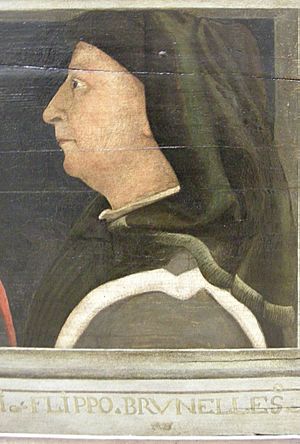
Filippo Brunelleschi in an anonymous portrait of the 2nd half of the 15th century (Louvre, Paris)
|
|
| Born |
Filippo di ser Brunellesco di Lippo Lapi
1377 Florence, Republic of Florence
|
| Died | 15 April 1446 (aged 68–69) Florence, Republic of Florence
|
| Known for | Architecture, sculpture, mechanical engineering |
|
Notable work
|
Dome of Santa Maria del Fiore |
| Movement | Early Renaissance |
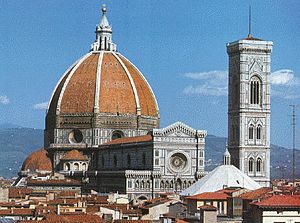
Filippo Brunelleschi (born 1377 – died April 15, 1446) was a talented Italian architect, designer, and sculptor. He is most famous for creating the huge dome of the Florence Cathedral. Most of his important works can still be seen in Florence, Italy.
Brunelleschi was also very interested in math and engineering. He even invented special machines that used water power and complex clocks. Sadly, none of these inventions still exist today.
Contents
Who was Filippo Brunelleschi?
Brunelleschi was born in Florence, Italy, in 1377. His parents, Brunellesco di Lippo and Giuliana Spini, were wealthy. His father worked as a notary and civil servant. Filippo had two brothers.
Young Filippo learned about literature and mathematics. When he was fifteen, he became an apprentice to the Arte della Seta. This was the richest and most important guild in Florence. It included wool merchants, jewelers, and metalworkers. By December 1398, he became a master goldsmith and a sculptor who worked with bronze.
Sculpture: The Baptistery Doors Competition
In 1401, Florence held a competition. They wanted new bronze doors for the Florence Baptistery. Brunelleschi and another young sculptor, Lorenzo Ghiberti, entered. Each artist had to create a bronze panel showing the Sacrifice of Isaac. It had to fit inside a Gothic four-leaf frame.
The head judge was Giovanni di Bicci de' Medici. The judges liked Ghiberti's work a lot. When they saw Brunelleschi's, they couldn't pick a winner. They suggested both artists work together. But Brunelleschi didn't want to share control. So, Ghiberti won the project.
After this, Brunelleschi focused on architecture and optics. He still took on some sculpture jobs until about 1416.
Brunelleschi's Famous Buildings
The Foundling Hospital (1419–1445)
Brunelleschi's first big building project was the Ospedale degli Innocenti. This was a home for orphans, started around 1419. Brunelleschi was the main architect until 1427. However, he wasn't on site much after 1423. Another architect, Francesco della Luna, finished the hospital in 1445.
Brunelleschi mostly built a long covered walkway called a loggia. It had nine arches supported by thin columns. These columns had special tops called Corinthian capitals. This walkway, with its columns, round arches, and simple design, became a model for many Renaissance buildings across Europe.
Its long loggia was unusual for the narrow, winding streets of Florence. The arches were very tall, about 8 meters high. The building looked serious and grand. It didn't use fancy marble or decorations. It was also the first building in Florence to clearly use ideas from classical antiquity (ancient Greek and Roman styles).
Soon, Brunelleschi got more jobs. These included the Ridolfi Chapel and the Barbadori Chapel. He used similar design ideas in these smaller projects. These smaller works helped him prepare for his most famous project: the dome of the Cathedral of Florence.
Basilica of San Lorenzo (1421–1442)
The Basilica of San Lorenzo was Brunelleschi's next major project. He started it soon after the Foundling Hospital. It was the largest church in Florence. The powerful Medici family paid for it, and their tombs were inside. Many architects worked on it, including Michelangelo later on.
Brunelleschi designed the main part of the church, called the central nave. He also designed the two side aisles with small chapels. And he built the Old Sacristy, a special room for priests.
In the Old Sacristy, Brunelleschi used white walls. This became a common design idea in Renaissance churches.
-
Vault of the Old Sacristy (Sagrestia vecchia), with the tomb of Giovanni di Bicci de' Medici
Basilica of Santo Spirito (1434–1466)
The Basilica of Santo Spirito in Florence was another big project. Brunelleschi worked on it at the same time as his other major buildings. He started designing it in 1434, but construction didn't begin until 1436. It was still being built after he died.
The columns for the front of the church arrived just ten days before Brunelleschi's death in 1446. The front was finished in 1482 and changed later. The bell tower was also added much later.
Santo Spirito shows how Brunelleschi used math to create balanced and beautiful designs.
Pazzi Chapel (1430–1444)
The Pazzi Chapel in Florence was ordered around 1429 by Andrea Pazzi. It was meant to be a meeting place for the monks of the Santa Croce Monastery. The building wasn't fully finished until about 1469, twenty years after Brunelleschi died. Some parts, like the small tower on top of the dome, were added later.
The entrance of the chapel, called the portico, is very special. It has beautiful proportions, looks simple, and feels very balanced. Light comes down from the round windows of the dome, changing throughout the day. The chapel's design uses rectangles, not just squares. This makes it look a little less balanced than his chapel in the Old Sacristy of San Lorenzo.
-
Interior of the Pazzi Chapel with sculptural plaques by Luca Della Robbia
Florence Cathedral Dome (1420–1461)
The Santa Maria del Fiore was the main church and symbol of Florence. It was started in 1296. After the first architect died, work stopped for fifty years. The bell tower was added by Giotto around 1330. Between 1334 and 1366, a group of architects and painters planned a huge dome. They swore to follow this plan.
The planned dome, from its base to the top lantern, was over 80 meters (260 feet) high. Its octagonal base was almost 42 meters (138 feet) wide. This was bigger than the dome of the ancient Pantheon in Rome. No dome of this size had been built in Europe since ancient times.
In 1418, a competition was held to choose the builder. Brunelleschi won! His friend, the sculptor Donatello, helped him by making a small brick model of the dome.
Building the dome (1420–1436), the lantern (1446–c. 1461), and the exedra (1439–1445) took up most of Brunelleschi's later life. His success came from his amazing technical and math skills. He used over four million bricks to build the octagonal dome. Brunelleschi didn't leave any building plans or diagrams. Experts believe he built the dome so it could support itself, like a half-sphere.
Brunelleschi built two domes, one inside the other. This idea was later used for all major domes, like those of Les Invalides in Paris and the United States Capitol in Washington.
He also invented a new machine to lift the heavy stones and bricks needed for the dome. Even Leonardo da Vinci admired this hoisting machine years later.
The dome's strength was improved by wooden and sandstone chains Brunelleschi invented. These acted like tight rings around the dome's base. This meant they didn't need the large supports called flying buttresses, which were common in Gothic buildings.
Brunelleschi kept his workers on the dome during breaks. He brought them food and watered-down wine. He thought climbing up and down hundreds of stairs would make them tired and less productive.
Once the dome was done, a new competition was held in 1436 for the decorative lantern on top. Brunelleschi won again! He designed the lantern and built its base. But he died before he could see it placed on top of the dome.
Brunelleschi's Other Achievements
Linear Perspective in Art
Brunelleschi is also known for being the first person to describe a clear system of linear perspective. This was a huge change for painting. It allowed artists to create realistic, three-dimensional scenes. He carefully studied how objects, buildings, and landscapes looked different from a distance or from different angles. He made drawings of the Florence Baptistery and other landmarks using correct perspective.
According to his early writer, Antonio Manetti, Brunelleschi did some experiments between 1415 and 1420. He made paintings of the Florence Baptistery and the Palazzo Vecchio with correct perspective. He used a grid to copy the scene exactly. He even made a reverse image. The results were pictures with accurate perspective, as if seen through a mirror.
To check his work, he made a small hole in his painting. An observer would look through the back of the painting at the real scene. Then, a mirror was raised to show Brunelleschi's painting. The observer could see how much the painting looked like reality. Sadly, both of these special paintings are now lost.
-
The Holy Trinity by Masaccio (1425–1427) used Brunelleschi's system of perspective
-
The Delivery of the Keys fresco by Perugino (1481–1482) uses linear perspective and Brunelleschi's architectural style
Other Interesting Activities
Brunelleschi also designed machines for churches. These were used during plays that showed Bible stories. Characters and angels could "fly" through the air with special lights and fireworks. We don't know how many of these he designed. But records confirm he made one for the church of San Felice.
He also designed strong defenses for Florence. These were used in wars against nearby cities like Pisa and Siena. In 1424, he worked in Lastra a Signa, a village that protected the road to Pisa. In 1431, he worked on walls in the south of Italy, in the village of Staggia. These walls still stand today.
Brunelleschi's Personal Life
Brunelleschi did not have his own children. But in 1415, he adopted Andrea de Lazzaro Cavalcanti. Andrea took the name Il Buggiano, after his hometown. He was Brunelleschi's only heir, meaning he inherited everything.
Interesting Facts About Filippo Brunelleschi
- Brunelleschi is seen as a founder of Renaissance architecture.
- As a child, he planned to follow his father and become a notary or civil servant.
- His earliest sculptures are two small bronze statues (1399–1400). They were made for an altar in Pistoia Cathedral.
- In 1402, Brunelleschi visited Rome. He might have gone with his friend, the sculptor Donatello. He studied ancient ruins there. This trip greatly influenced his building designs.
- In 1421, Brunelleschi was the first person in the Western world to get a patent. This was for a river boat he invented. It was meant to carry marble.
- Brunelleschi's body is buried in the crypt of the Florence Cathedral. Inside the entrance, there's an epitaph that praises his amazing skill. It says Florence will always remember him.
- A statue of Brunelleschi, looking up at his dome, stands in the square in front of the cathedral.
- Alessandro Preziosi played Brunelleschi in the 2016 TV series Medici: Masters of Florence.
Principal Works
Here are the main buildings and works designed by Brunelleschi, or where he was involved. All are in Florence:
- Dome of the Florence Cathedral (1419–1436)
- Ospedale degli Innocenti (1419–c.1445)
- The Basilica of San Lorenzo (1419–1480s)
- Meeting Hall of the Palazzo di Parte Guelfa (1420s–1445)
- Sagrestia Vecchia, or Old Sacristy of S. Lorenzo (1421–1440)
- The lantern of Florence Cathedral (1436–c.1450)
- The exedrae of Florence Cathedral (1439–1445)
- The church of Santo Spirito (1441–1481)
- Pazzi Chapel (1441–1460s)
Images for kids
-
Michelangelo's plan for Saint Peter's Basilica, Rome (1546), superimposed on the earlier plan by Bramante
See also
 In Spanish: Filippo Brunelleschi para niños
In Spanish: Filippo Brunelleschi para niños


